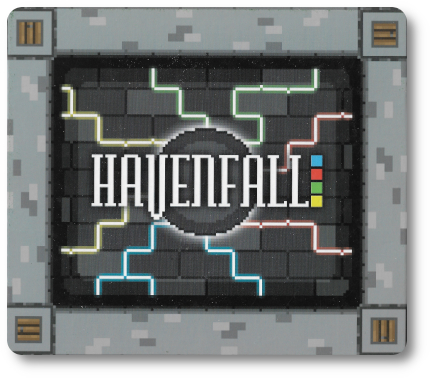
The Basics:
- For ages 10 and up
- For 2 to 4 players
- Approximately 120 minutes to complete
Geek Skills:
- Active Listening & Communication
- Counting & Math
- Logical & Critical Decision Making
- Reading
- Pattern/Color Matching
- Strategy & Tactics
- Risk vs. Reward
- Hand/Resource Management
Learning Curve:
- Child – Easy
- Adult – Easy
Theme & Narrative:
- Be the hero of legend and rid the world of corruption
Endorsements:
- Gamer Geek mixed
- Parent Geek mixed
- Child Geek mixed
Overview
Evil has always existed. It mostly stays in the shadows, on the fringes of society, corrupting the weak. But this is changing and the kingdom is in peril. Demonic forces are entering the world and evil is growing stronger. Take up sword and spell book and go forth into the land, fighting foes and saving friends. The kingdom stands on the edge of ruin, but through your bravery, the city of Havenfall will stand the land can be healed.
Havenfall, designed, self-published, and illustrated by Joe Yzquierdo, is comprised of one game board, one scoreboard, one Tracker board, four Leaders, four meeples, four Player boards, and a lot of cards. The cards are as thick and as durable as your standard playing card. The illustrations are 8-bit retro video game inspired, from the card art to the game board that looks like a “world map”.
C:\FatherGeek\GameTable\> load Havenfall.exe
To set up the game, first place the game board in the middle of the playing area and within easy reach of all the players. Next to the game board, place the scoreboard, tracker, and Pixel cubes.
Second, take all the “Silver” and “Gold” cards and place them on their locations, face-up, on the game board.
Third, shuffle the Artifact cards, randomly deal two face-up to each color (blue, red, green, and yellow) and then discard any remaining Artifact cards back to the game box.
Fourth, take the Hero cards and place to the game board face-up on their designated Rank location.
Fifth, take the Spell cards, shuffle, and place the deck face-down on the marked location on the game board. Then take the Monster cards, shuffle, place face-down on the marked location on the game board. Draw the first three. From left to right, place in the Minion locations and then the Boss location on the game board, face-up.
Sixth, give to each player seven Copper, one Sword, one Shield, and one Spell Book cards. These cards make up the player’s starting deck.
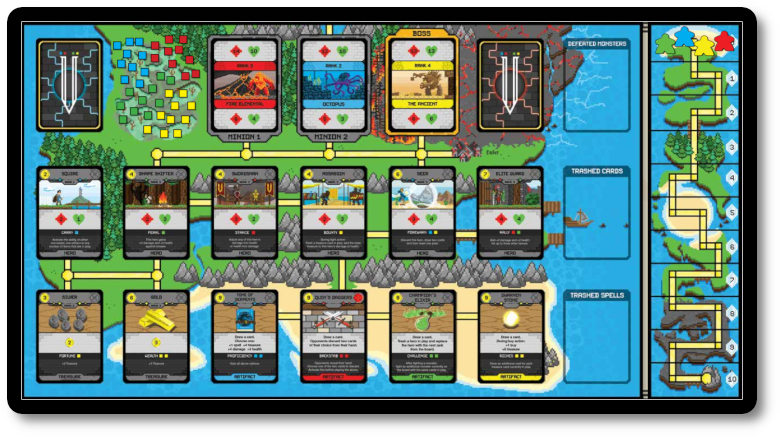
Seventh, shuffle the War Room boards and deal one to each player. These are placed face-up in front of their owning player.
Eight, deal one Leader to each player. Each player then collects one Pixel cube of the color that matches their Leader card color. If needed, hand to each player a Turn Order card at this time.
That’s it for game set up. Have each player draw the first five cards from their draw deck to create their starting hand. Time to save Havenfall!
Game Options
Havenfall is a deck-building game. As such, the primary focus of the game and the game play is collecting cards and streamlining the player’s draw deck so as to continue to draw, and with increasing frequency, empowering cards. All players start the game with the same cards, which are not bad, but are designed to create a solid foundation on which the player is meant to build off of and then abandon. Let’s take a look at the primary cards to be used.
The Treasure
The Treasure in the game is used to purchase cards when the player uses the Buy action. Little is given to the player to start with. They can increase their wealth and buying power as the game continues.
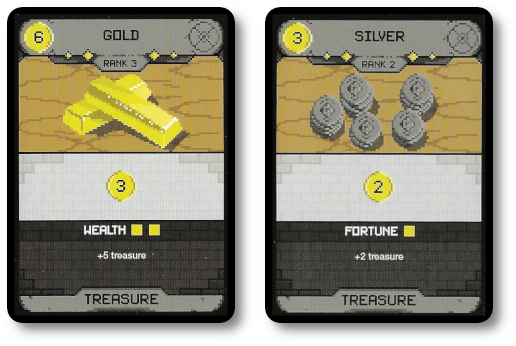
The Heroes and Leaders
Hero cards are purchased during the game, improving the player’s ability to attack monsters. They have a rank value, hit damage, health points, and special abilities that are paid for during the game by using collected Pixel cubes. Leaders are essentially more powerful Hero cards.
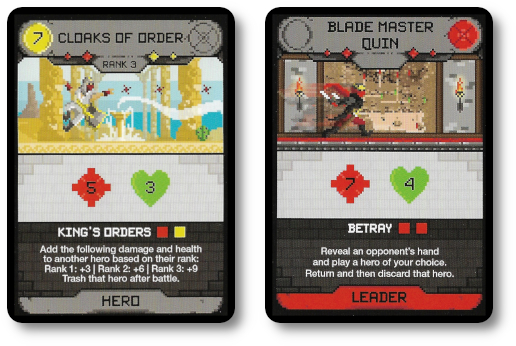
The Monsters
Monster cards in the game display the creatures hit damage and health, similar to Hero and Leader cards, but with a twist. The top values is used if the Monster card is in the “Boss” location on the game board. The bottom values are used if the Monster card is in either of the two “Minion” locations. The Rank value is used when keeping track of victory points earned if the killed Monster card was a Boss.
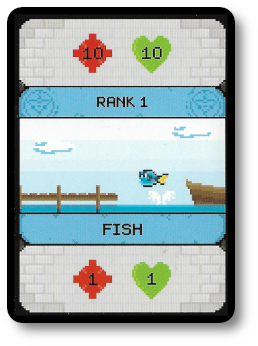
BIG difference between minion fish and boss fish
The Items and Artifacts
To help the player take on the nasty monsters, they can equip their Heroes and Leader with Items and Artifacts. In game terms, these are temporary bonuses applied to the player’s hand when they take an action. Item and Artifact cards can be further leveraged by purchasing their bonus ability with Pixel cubes.
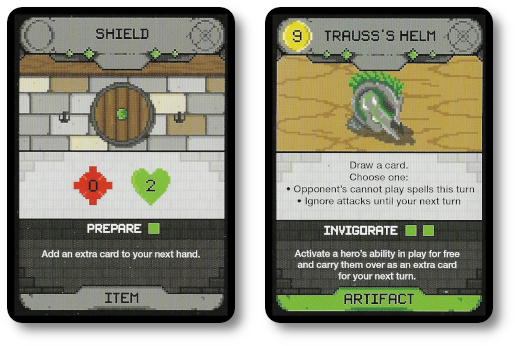
The Spells
Each player starts with a “Spell Book” Item card that allows the player to collect Spell cards (which you have to pay for in Pixels). Once the Spell card is in the player’s possession, it can be used in a similar fashion as Items and Artifacts. Which is to say, the player pays the Pixel cost to trigger the Spell’s abilities. Unlike Item and Artifact cards, Spells can be played during or out of the player’s turn whenever the Spell’s ability is applicable and can be used on demand rather than waiting for them to turn up in hand. This makes Spell cards highly useful, as they improve the player’s ability to adjust their strategy based on the changing conditions in the game.
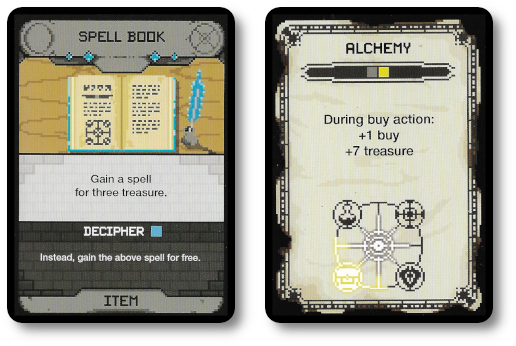
Pixel Pusher
Each player is given a War Room board. This is used to help keep track of the Pixel cubes used during a player’s turn. When the player starts their turn, all the Pixel cubes they have collected are made available to them by sliding them to the left most location on the War Room board. When the player takes their turn, they move used Pixels from the right side of the War Room board (available) to the left side (exhausted). Abilities on cards take a specific number of Pixel cubes and colors. The War Room board is meant to help keep track of the Pixel resources available to the player at all times in a simple and efficient manner.

Ready Player One
Havenfall is played in rounds and turns. A player’s turn is summarized here.
Step One: Reveal Cards
All the cards in the player’s hand are placed in front of them when it’s their turn. Cards remain hidden from opponents until played. Based on the cards in the player’s hand, they must now announce to their opponents what action they will be taking.
Step Two: Take One Action
The player can take one action during their turn, but based on the action selected and the cards available in their hand, the same action can be taken multiple times. Each action is summarized here.
Buy Cards
By default, a player can buy one visible card on the game board if they have enough treasure. Some cards will have abilities that increase the number of times a player can buy a card and the amount of treasure available to spend. The purchased card is taken from the game board and placed in the player’s personal discard pile. There it will remain until the discard pile is shuffled and creates the new draw deck.
Trash Cards
At the cost of one Pixel cube of any color, the player can take one card from their hand and place it to the Trash location on the game board. This can be done as many times as the player likes, as long as they have Pixel cubes to spend and cards to get rid of. This is the only means available to the player who wants to streamline their hand, removing no longer useful cards from their deck, increasing the odds of drawing the cards they need to win each turn.
Fight Monsters
Three or fewer Monster cards will be visible to the player on their turn. These will be two Minions and one Boss Monster card, with the type being determined by the card’s location on the game board. To defeat a monster, the player must be able to match or exceed both the hit damage and health of the Monster card they are targeting. A Tracker card is provided to help the player tally up the points from Hero cards, the Leader card, Item cards, Artifact cards, and Spell cards. Opponents can use Spell cards to offset the Monster card’s abilities and strengths, making combat possibly more complicated.
Combat comes in two forms. Physical attack and arcane attack. Both are the same when determining damage the player inflicts on the targeted Monster card. Arcane attacks, however, are much more powerful and can provide the player a unique ability that can be used as an advantage to them or a disadvantage to their opponent.
If a monster is defeated, it’s removed and placed in the Defeated Monster location on the game board. All Monster cards still on the game board slide to the open position to their left. A new Monster card is then drawn and placed in the Boss location, face-up. The player who defeated the monster collects one Pixel cube matching the monster’s color and places it on the “exhausted” side of their War Room board. If the monster defeated was in the Boss location, the player also collects victory points equal to the Monster card Rank value.
Spells: The Magical Bonus Action
Spell cards and spell abilities (earned through Hero, Leader, and Artifact cards) can be paid for and triggered anytime during the player’s turn where applicable to one of the three actions the player elected to take. They can also be used anytime during the game (again, where applicable), allowing the player to interfere with their opponent’s.
When spells are collected, they are not placed in the player’s discard pile or in the player’s draw deck. Instead, they are placed in a separate pile and face-down (for a maximum of five Spell cards). The player can pull from this pile of cards, pay the Pixel cost, and resolve the Spell card’s ability. Unlike the other cards available to the player, used Spell cards are not placed to their discard pile when used. Instead, they are permanently trashed, making each Spell card powerful and limited in its use.
Step Three: Clean Up
Once the player has completed their turn, all cards in their hand are placed face-up in their discard pile. The player then draws a new hand of five cards. If there are not enough cards in their draw deck, the discard pile is shuffled, placed face-down, and becomes the new draw deck.
Game Over
The game continues, with players augmenting their deck with purchased cards, trashing ones they no longer need, attacking monsters, and upsetting the plans of their opponents until one player has collected ten or more victory points (by taking out “Boss” Monster cards) on their turn. The round is then finished, ensuring everyone has the same number of turns. The player with the most victory points at the end of the game is the winner.
Game Variants
The rules and game play summarized here (referred to as “Free for All”) are those described in the rule book that came with the game. Additional ways of playing the game are available from the publisher’s website. These include a quick play variant, team play, and a solitaire version. We did not play with the game variants provided on the website for this review. Give them a look if you are interested.
To learn more about Havenfall, visit the game’s website.
Final Word
 The Child Geeks were able to quickly learn the game and loved how it looked. According to one Child Geek, “I like how the game looks like a video game. Reminds me of the games my dad use to play and keeps telling me were the best games in the world.” The pixel art is excellent in the game and the time and attention to detail regarding it use is apparent throughout its presentation and game play. Another Child Geek said, “I like the game, but I think adding up all the cards can take too long and can get hard.” Ah, yes. This is the first of the rumblings I heard regarding the game’s math, as the Child Geeks just happened to be the first playing group we presented Havenfall to. Turns out the math in the game is easy for the Child Geeks, but after awhile, it got to be too much. This caused the games to be slowed down and the level of frustration grew as a result. By the time all the games were over, the Child Geeks either really enjoyed Havenfall or were too emotionally drained from the math to give the game much thought, resulting in a mixed endorsement from the Child Geeks.
The Child Geeks were able to quickly learn the game and loved how it looked. According to one Child Geek, “I like how the game looks like a video game. Reminds me of the games my dad use to play and keeps telling me were the best games in the world.” The pixel art is excellent in the game and the time and attention to detail regarding it use is apparent throughout its presentation and game play. Another Child Geek said, “I like the game, but I think adding up all the cards can take too long and can get hard.” Ah, yes. This is the first of the rumblings I heard regarding the game’s math, as the Child Geeks just happened to be the first playing group we presented Havenfall to. Turns out the math in the game is easy for the Child Geeks, but after awhile, it got to be too much. This caused the games to be slowed down and the level of frustration grew as a result. By the time all the games were over, the Child Geeks either really enjoyed Havenfall or were too emotionally drained from the math to give the game much thought, resulting in a mixed endorsement from the Child Geeks.
 The Parent Geeks also had no issues with learning the game and gushed over its artwork with nostalgic excitement, recounting the many hours of video games they used to have the time to play. The Parent Geeks quickly demonstrated their skills in purchasing the right cards and taking out the bosses for points toward victory. Then they hit the same speed bump as the Child Geeks. According to one Parent Geek, “The game starts out easy and remains so, but the turns take longer and longer due to the math. There are lots of things for a player to do and each require you to keep numbers in your head. Sometimes I feel that there are too many.” Another Parent Geek said, “I found the game fun and challenging, but if you don’t’ like math, you won’t like this game. They should have called this game Math Land or something.” In the end, roughly half of the Parent Geeks found Havenfall to be fun and challenging. The other half thought so, as well, but the amount of math and the slowing down of each turn as the game progressed dampened their joy. This resulted, like the Child Geeks, in a mixed level of endorsement.
The Parent Geeks also had no issues with learning the game and gushed over its artwork with nostalgic excitement, recounting the many hours of video games they used to have the time to play. The Parent Geeks quickly demonstrated their skills in purchasing the right cards and taking out the bosses for points toward victory. Then they hit the same speed bump as the Child Geeks. According to one Parent Geek, “The game starts out easy and remains so, but the turns take longer and longer due to the math. There are lots of things for a player to do and each require you to keep numbers in your head. Sometimes I feel that there are too many.” Another Parent Geek said, “I found the game fun and challenging, but if you don’t’ like math, you won’t like this game. They should have called this game Math Land or something.” In the end, roughly half of the Parent Geeks found Havenfall to be fun and challenging. The other half thought so, as well, but the amount of math and the slowing down of each turn as the game progressed dampened their joy. This resulted, like the Child Geeks, in a mixed level of endorsement.
 The Gamer Geeks liked the artwork (of course), the game components, and the rules. The majority thought the level of math needed to calculate the results of their actions to be fiddly and in much need of tightening up. According to one Gamer Geek, “Good stuff in here. I especially like how you can always trash your cards, but at the cost of a turn. What I think the game could use is better resolution of the turn. The amount of math needed to determine the results can get a bit silly. I found myself not calculating some cards out of laziness during the end part of the game.” Again, we hear about the math. By this time, I had played the game and had a better understanding of what the players were discussing. As such, I pressed for more information. One Gamer Geek responded, “Look, the game is not broken. It’s just heavy on the resolution portion of the turn. It isn’t difficult, but it does feel like you put more time and energy into doing the math part of your turn rather than figuring out what you want to do on your turn.” The Gamer Geeks voted and believed that Havenfall was a game they’d play again, but would not necessarily seek out.
The Gamer Geeks liked the artwork (of course), the game components, and the rules. The majority thought the level of math needed to calculate the results of their actions to be fiddly and in much need of tightening up. According to one Gamer Geek, “Good stuff in here. I especially like how you can always trash your cards, but at the cost of a turn. What I think the game could use is better resolution of the turn. The amount of math needed to determine the results can get a bit silly. I found myself not calculating some cards out of laziness during the end part of the game.” Again, we hear about the math. By this time, I had played the game and had a better understanding of what the players were discussing. As such, I pressed for more information. One Gamer Geek responded, “Look, the game is not broken. It’s just heavy on the resolution portion of the turn. It isn’t difficult, but it does feel like you put more time and energy into doing the math part of your turn rather than figuring out what you want to do on your turn.” The Gamer Geeks voted and believed that Havenfall was a game they’d play again, but would not necessarily seek out.
 If I were to describe Havenfall in one word it would be “mathy”. Which, admittedly, is not a real word, but is slang for anything that requires a good deal of calculations. You don’t need to be a scientist to do the math in the game, as it’s all pretty simple arithmetic. What you do need is a way to keep track of all the different triggers that can be used to keep adding to the score. For example, you’ll first calculate the amount of damage inflicted by your Hero or Leader, then add in your Item and Artifact cards. Then you’ll want to see how many special abilities you want to use, which will require you to decrease the number of Pixels and then add more to your total. I haven’t even looked at my Spells yet, which will add more. I cannot emphasis enough how simple the math is. We are adding small number here. It becomes problematic, however, when you have to recalculate again and again. There were several times I know I forgot to add a bonus or three simply because I was rushing the math to keep the game going.
If I were to describe Havenfall in one word it would be “mathy”. Which, admittedly, is not a real word, but is slang for anything that requires a good deal of calculations. You don’t need to be a scientist to do the math in the game, as it’s all pretty simple arithmetic. What you do need is a way to keep track of all the different triggers that can be used to keep adding to the score. For example, you’ll first calculate the amount of damage inflicted by your Hero or Leader, then add in your Item and Artifact cards. Then you’ll want to see how many special abilities you want to use, which will require you to decrease the number of Pixels and then add more to your total. I haven’t even looked at my Spells yet, which will add more. I cannot emphasis enough how simple the math is. We are adding small number here. It becomes problematic, however, when you have to recalculate again and again. There were several times I know I forgot to add a bonus or three simply because I was rushing the math to keep the game going.
This is not a knock against the game, but it was a buzz kill for our players. A real shame, as Havenfall is very easy to teach and to learn. It’s also easy to play, except for the time and attention needed to do all the math. There is a tracker available to the players to help them keep track of the points, but this is little more than a cardboard version of the abacus, with the player moving cubes into different number positions. You still have to do the math which can be adjusted from multiple sources.
The game can also feel like it’s taking much longer than expected…or too short. The game ends when any player has enough victory points through defeated “Boss” Monster cards. This means the game ends when the players get around to it. If you are playing an aggressive opponent who knows their way around a deck-building game, your games won’t last much longer than an hour at the very most. If you are playing with new players to the game, very casual ones, or with individuals who like disrupting opponents’ turns with troublesome card plays, expect your games to run longer. Eventually the game will end, but not until the players want it to. And when they do, they have to work for it.
Overall, I liked the game. I’ve played many deck-builders and Havenfall is not bad. Nor is it great. I’ve played deck-builders that are tighter and faster. One thing Havenfall brings to the table is the ability to really dive deep into the strategy, combo cards, and bleed the game for every bonus point it’s worth. This is where the “mathy” portion comes into play, but a player need not always calculate every little point or two on their turn. You only need enough to do the job and complete the action. Better put, just do enough calculating until you get the number you need and forget about the rest. You don’t get extra points for having a larger value than needed. All it shows is that you crazy overkilled the objective. Which, honestly, can also feel pretty good.
If you like deck-building games and want to take a trip down memory lane into the fantasy world of video games of old brought back to life on your gaming table, do give Havenfall a try. It can be learned quickly and feels like an adventure. Just make sure you bring your calculator.
This game was given to Father Geek as a review copy. Father Geek was not paid, bribed, wined, dined, or threatened in vain hopes of influencing this review. Such is the statuesque and legendary integrity of Father Geek.



